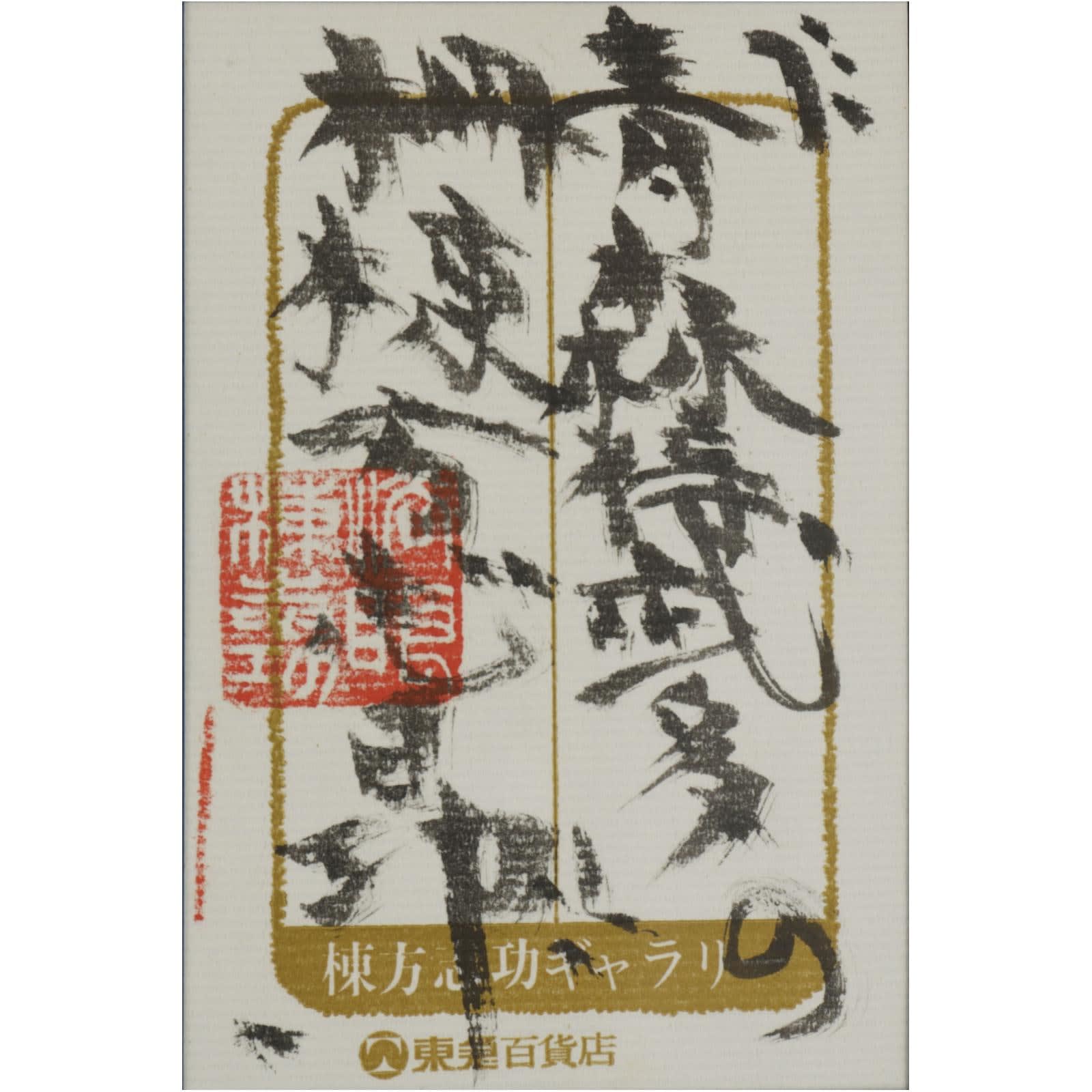Munakata Shikō (1903–1975)
Neputa Festival in Aomori
Hand-colored woodblock on paper, framed
Dated Showa 45 (1970)
With a label signed by the artist
Seal: Muna
45.3 x 35 cm (plate)
61.5 x 47.6 cm (sheet)
73 x 58 cm (overall)
Dated Showa 45 (1970)
With a label signed by the artist
Seal: Muna
45.3 x 35 cm (plate)
61.5 x 47.6 cm (sheet)
73 x 58 cm (overall)
Further images
Literature
Cover art of Munakata Shiko zenshu vol. 10. Tokyo: Kodansha, 1978.Munakata Shiko hanga zenshu. Tokyo: Kodansha, 1985.
This work depicts a lavishly decorated oat at the Nebuta Matsuri, the representative festival of Aomori, hometown of Munakata Shiko . In rich colors hand-applied both on the back and front of the paper, Munakata captured the air of the bustling, festive evening through his vivid portrayal of the oat, which represents the legendary fight between Ushiwakamaru and Benkei on Gojo Bridge. In his signed label of the work, Munakata wrote Aomori Nebuta no saku in kanji characters, whereas at the bottom of the print, he signed in kana scripts in pencil: “Aomori / Neputa.” It seems that Munakata had pronounced the name of the festival as “Neputa.” Embodying the root of the artist, the subject of Neputa is recurrently represented in Munakata’s woodblock prints and paintings.
Munakata Chutaro , a relative of Munakata, excelled at paintings and painted the dolls decorating the Neputa oats. It is said that in his childhood, Munakata greatly admired Chutaro. In a photograph of the Neputa oat with the dolls of Ushiwakamaru and Benkei made by Chutaro, Munakata inscribed that it is the masterpiece of Chutaro . For Munakata, the fighting of Ushiwakamaru and Benkei must be the archetypical Neputa subject and one that he had longed to work on since his early years.
Moreover, this work appears as the cover image of volume 10 of Munakata Shiko zenshu, the collection of Munakata’s complete works, including woodblock prints and paintings. It is also reproduced in Munakata Shiko hanga zensaku (Complete woodblock works of Munakata Shiko). The present work is undoubtedly one of Munakata’s most recognized and favored prints, which demonstrates his matured style and technique, and encapsulates the artist’s lifelong, nostalgic longing for his hometown.
Munakata Shiko (woodblock print artist; 1903−1975)
Aomori-born woodblock print artist. First taught himself Western-style painting, and was admitted to exhibit at Teiten (Imperial Academy of Fine Arts Exhibition). Aspired to become a woodblock print artist under the influence of the print artists Furukawa Ryusei and Kawakami Sumio. Acquaintance with the founding members of the Mingei movement Yanagi Muneyoshi, Kawai Kanjiro and Hamada Shoji had brought transformation in his artmaking. Later produced a great many masterpieces on religious subjects. Built up a unique form of woodblock print that brings writings into the picture, combining and harmonizing the visual effects of the two elements. Designated as a Person of Cultural Merit and received the Order of Culture.
Munakata Chutaro , a relative of Munakata, excelled at paintings and painted the dolls decorating the Neputa oats. It is said that in his childhood, Munakata greatly admired Chutaro. In a photograph of the Neputa oat with the dolls of Ushiwakamaru and Benkei made by Chutaro, Munakata inscribed that it is the masterpiece of Chutaro . For Munakata, the fighting of Ushiwakamaru and Benkei must be the archetypical Neputa subject and one that he had longed to work on since his early years.
Moreover, this work appears as the cover image of volume 10 of Munakata Shiko zenshu, the collection of Munakata’s complete works, including woodblock prints and paintings. It is also reproduced in Munakata Shiko hanga zensaku (Complete woodblock works of Munakata Shiko). The present work is undoubtedly one of Munakata’s most recognized and favored prints, which demonstrates his matured style and technique, and encapsulates the artist’s lifelong, nostalgic longing for his hometown.
Munakata Shiko (woodblock print artist; 1903−1975)
Aomori-born woodblock print artist. First taught himself Western-style painting, and was admitted to exhibit at Teiten (Imperial Academy of Fine Arts Exhibition). Aspired to become a woodblock print artist under the influence of the print artists Furukawa Ryusei and Kawakami Sumio. Acquaintance with the founding members of the Mingei movement Yanagi Muneyoshi, Kawai Kanjiro and Hamada Shoji had brought transformation in his artmaking. Later produced a great many masterpieces on religious subjects. Built up a unique form of woodblock print that brings writings into the picture, combining and harmonizing the visual effects of the two elements. Designated as a Person of Cultural Merit and received the Order of Culture.







